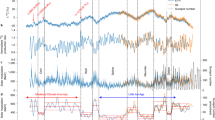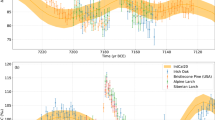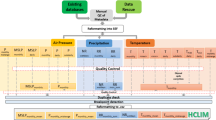Abstract
Direct observations of sunspot numbers are available for the past four centuries1,2, but longer time series are required, for example, for the identification of a possible solar influence on climate and for testing models of the solar dynamo. Here we report a reconstruction of the sunspot number covering the past 11,400 years, based on dendrochronologically dated radiocarbon concentrations. We combine physics-based models for each of the processes connecting the radiocarbon concentration with sunspot number. According to our reconstruction, the level of solar activity during the past 70 years is exceptional, and the previous period of equally high activity occurred more than 8,000 years ago. We find that during the past 11,400 years the Sun spent only of the order of 10% of the time at a similarly high level of magnetic activity and almost all of the earlier high-activity periods were shorter than the present episode. Although the rarity of the current episode of high average sunspot numbers may indicate that the Sun has contributed to the unusual climate change during the twentieth century, we point out that solar variability is unlikely to have been the dominant cause of the strong warming during the past three decades3.
This is a preview of subscription content, access via your institution
Access options
Subscribe to this journal
Receive 51 print issues and online access
$199.00 per year
only $3.90 per issue
Buy this article
- Purchase on Springer Link
- Instant access to full article PDF
Prices may be subject to local taxes which are calculated during checkout




Similar content being viewed by others
References
Hoyt, D. V. & Schatten, K. H. Group sunspot numbers: A new solar activity reconstruction. Sol. Phys. 179, 189–219 (1998)
Eddy, J. A. The Maunder minimum. Science 192, 1189–1202 (1976)
Solanki, S. K. & Krivova, N. Can solar variability explain global warming since 1970? J. Geophys. Res. 108, doi: 10.1029/2002JA009753 (2003)
Stuiver, M. & Braziunas, T. F. Atmospheric 14C and century-scale solar oscillations. Nature 338, 405–408 (1989)
Stuiver, M. & Braziunas, T. F. Sun, ocean, climate and atmospheric 14CO2: an evaluation of causal and spectral relationships. Holocene 3, 289–305 (1993)
Damon, P. E. & Sonett, C. P. in The Sun in Time (eds Sonnet, C. P., Giampapa, M. S. & Matthews, M. S.) 360–388 (Univ. Arizona, Tucson, 1991)
Beer, J. et al. Use of 10Be in polar ice to trace the 11-year cycle of solar activity. Nature 347, 164–166 (1990)
Beer, J. Long-term indirect indices of solar variability. Space Sci. Rev. 94, 53–66 (2000)
Solanki, S. K., Schüssler, M. & Fligge, M. Evolution of the Sun's large-scale magnetic field since the Maunder minimum. Nature 408, 445–447 (2000)
Solanki, S. K., Schüssler, M. & Fligge, M. Secular variation of the Sun's magnetic flux. Astron. Astrophys. 383, 706–712 (2002)
Usoskin, I. G., Alanko, K., Mursula, K. & Kovaltsov, G. A. Heliospheric modulation strength during the neutron monitor era. Sol. Phys. 207, 389–399 (2002)
Usoskin, I. G., Mursula, K., Solanki, S. K., Schüssler, M. & Kovaltsov, G. A. A physical reconstruction of cosmic ray intensity since 1610. J. Geophys. Res. 107, doi:10.1029/2002JA009343 (2002)
Usoskin, I. G., Mursula, K., Solanki, S. K., Schüssler, M. & Alanko, K. Reconstruction of solar activity for the last millenium using 10Be data. Astron. Astrophys. 413, 745–751 (2004)
Usoskin, I. G., Solanki, S. K., Schüssler, M., Mursula, K. & Alanko, K. A millenium scale sunspot number reconstruction: evidence for an unusually active Sun since the 1940s. Phys. Rev. Lett. 91, 211101 (2003)
Stuiver, M. & Pollach, P. Discussion: reporting of 14C data. Radiocarbon 19, 355–363 (1977)
Stuiver, M. et al. INTCAL98 Radiocarbon age calibration. Radiocarbon 40, 1041–1083 (1998)
Broecker, W. S. An unstable superconveyor. Nature 367, 414–415 (1994)
Bond, G. et al. Persistent solar influence on North Atlantic surface circulation during the Holocene. Science 294, 2130–2136 (2001)
Muscheler, R., Beer, J. & Kromer, B. Solar Variability as an Input to the Earth's Environment 305–316 (ESA SP-535, European Space Agency, Noordwijk, 2003)
Bard, E., Raisbeck, G. M., Yiou, F. & Jouzel, J. Solar modulation of cosmogenic nuclide production over the last millennium: comparison between 14C and 10Be records. Earth Planet. Sci. Lett. 150, 453–462 (1997)
Usoskin, I. G. & Kromer, B. Reconstruction of the 14C production rate from measured relative abundance. Radiocarbon (in the press)
Suess, H. E. Radiocarbon content in modern wood. Science 122, 415–417 (1955)
Elsasser, W., Ney, E. P. & Winckler, J. R. Cosmic-ray intensity and geomagnetism. Nature 178, 1226–1227 (1956)
Castagnoli, G. & Lal, D. Solar modulation effects in terrestrial production of carbon-14. Radiocarbon 22, 133–158 (1980)
Hongre, L., Hulot, G. & Khokhlov, A. An analysis of the geomagnetic field over the past 2000 years. Phys. Earth Planet. Inter. 106, 311–335 (1998)
Yang, S., Odah, H. & Shaw, J. Variations in the geomagnetic dipole moment over the last 12000 years. Geophys. J. Int. 140, 158–162 (2000)
Author information
Authors and Affiliations
Corresponding author
Ethics declarations
Competing interests
The authors declare that they have no competing financial interests.
Supplementary information
Supplementary Information
Estimates of errors of sunspot number reconstruction from 14C data. (PDF 171 kb)
Rights and permissions
About this article
Cite this article
Solanki, S., Usoskin, I., Kromer, B. et al. Unusual activity of the Sun during recent decades compared to the previous 11,000 years. Nature 431, 1084–1087 (2004). https://doi.org/10.1038/nature02995
Received:
Accepted:
Issue Date:
DOI: https://doi.org/10.1038/nature02995
This article is cited by
-
Atmospheric radiocarbon levels were highly variable during the last deglaciation
Communications Earth & Environment (2023)
-
Centennial-scale monsoon collapses during Marine Isotope Stage (MIS)7e detected in a northern Chinese stalagmite record
Science China Earth Sciences (2023)
-
Correlation analysis between the occurrence of epidemic in ancient China and solar activity
Science China Earth Sciences (2023)
-
Long-Term Modulation of Solar Cycles
Space Science Reviews (2023)
-
Models for the long-term variations of solar activity
Living Reviews in Solar Physics (2023)
Comments
By submitting a comment you agree to abide by our Terms and Community Guidelines. If you find something abusive or that does not comply with our terms or guidelines please flag it as inappropriate.



